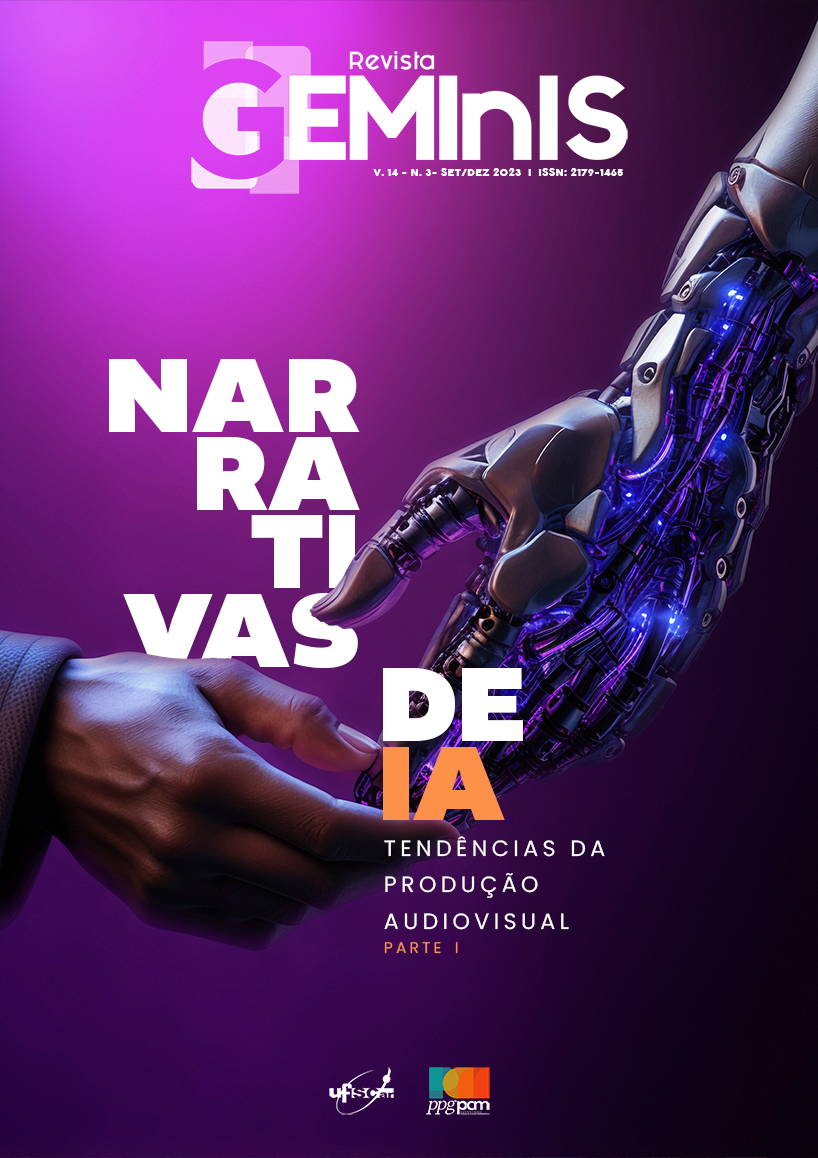AUDIOVISUAL AND ARTIFICIAL INTELLIGENCE
AUTONOMOUS TOOLS IN CONTENT PRODUCTION
DOI:
https://doi.org/10.14244/2179-1465.RG.2023v14i3p87-104Keywords:
Audiovisual production, Artificial intelligence, Production of meaning.Abstract
Digital tools with resources based on data analysis and artificial intelligence open up the prospect of transformations in the audiovisual field. With the aim of reflecting on experiences in the use of artificial intelligence in the production of audiovisual content, this paper analyses projects derived, in whole or in part, from the generation of autonomous texts using natural language processing and computer vision resources. In the experiments analysed, important limitations were observed in the process of processing unstructured data and identifying patterns using text and image analysis tools. Based on discursive semiotics, the article points out that although there are gaps in the production of meaning in these contents, this does not jeopardise the communication contract.
Downloads
References
ASIMOV, Isaac. Runaround. 1942. In: ASIMOV, Isaac. I, Robot. Nova York: Gnome Press,1950.
BERTRAND, Denis. Caminhos da semiótica literária. Tradução do Grupo CASA. Bauru: EDUSC, 2003.
CHOMSKY, Noan. Syntactic Structures. 1ª ed. Alemanha: Mouton & Co.1957.
FLOCH, Jean-Marie. Alguns conceitos fundamentais em semiótica geral. Tradução Analice Dutra Pilar. In: Documentos de estudos do centro de pesquisas sociossemióticas. São Paulo. 2001.
GUNKEL, David J. Comunicação e inteligência artificial: novos desafios e oportunidades para a pesquisa em comunicação. Galaxia (São Paulo, online), n. 34, jan-abr., 2017.
IBM. Scaling Wimbledon’s video production of highlight reels through AI technology. 2017, disponível em: < https://www.ibm.com/blogs/research/2017/06/scaling-wimbledons-video-productionhighlight-reels-ai-technology/> acesso em: 20 jan. 2019.
MCCARTHY, John. et al. A Proposal for the Dartmouth Summer Research Project on Artificial Intelligence - 1955. AI Magazine, v. 27, n. 4, jan/mar, 2006.
MCKEOWN, Lewis. An evaluation of the Impact of Constraints on the Perceived Creativity of Narrative Generating Software. University of Kent. Reino Unido. 2017.
MÉDOLA, Ana Silvia Lopes Davi. Televisão digital brasileira e os novos processos de produção de conteúdos: os desafios para o comunicador. ECompós, v.12 n.3, set/dez, 2009.
NORVING, Peter; RUSSEL, Stuart. Inteligência artificial. Tradução de Regina Célia Simille de Macedo. 3ª ed. Rio de Janeiro: Elsevier, 2013.
SMITH, John. R. IBM Research Takes Watson to Hollywood with the First “Cognitive Movie Trailer”. 2016, disponível em: < https://www.ibm.com/blogs/think/2016/08/cognitive-movie-trailer/> acesso em: 20 jan. 2019.
WAZLAWICK, Raul Sidnei. História da computação. 1 ed. Rio de Janeiro: Elsevier, 2016.
XAVIER, Ismail. O discurso cinematográfico: opacidade e transparência. 3 ed. São Paulo: Paz e Terra, 2005.
Filmografia BLADE Runner. Direção: Ridley Scott. Produção: Michael Deeley. Estados Unidos: Warner Bros. Pictures. 1982. 1 DVD (117 min)
DIA em que a Terra Parou, O. Direção: Robert Wise. Produção: Julian Blaustein. Estados Unidos: 20th Century Fox. 1951. 1 DVD (132 min).
: Uma Odisseia no Espaço. Direção: Stanley Kubrick. Produção: Stanley Kubrick. Estados Unidos: Metro-Goldwyn-Mayer. 1951. 1 DVD (148 min)
EXTERMINADOR do Futuro, O. Direção: James Cameron. Produção: Gale Anne Hurd. Estados Unidos: Orion Pictures. 1984. 1 DVD (107 min)
INDEPENDENCE Day. Direção: Roland Emmerich. Produção: Dean Devlin. Estados Unidos: 20th Century Fox. 1996: 1 DVD (145 min)
MATRIX. Direção: Lilly Wachowski e Lana Wachowski. Produção: Joel Silver. Estados Unidos: Warner Bros. 1999. 1 DVD (136 min)
MORGAN. Direção: Luke Scott. Produção: Ridley Scott, Michael Schaefer e Mark Huffam. Estados Unidos: 20th Century Fox. 2016. 1 DVD (92 min)
SUNSPRING. Direção: Oscar Sharp. Produção: Andrew Kortschak, Walter Kortschak, Andrew Swett e Allison Friedman. Reino Unido: End Cue. 2016. 1 vídeo (9 min). Disponível em: <https://www.youtube.com/watch?v=LY7x2Ihqjmc>. Acesso em 22 out. 2022.
Downloads
Published
How to Cite
Issue
Section
License
Copyright (c) 2024 Ana Silvia Lopes Davi Médola, Vinicius Laureto de Oliveira, Henrique da Silva Pereira

This work is licensed under a Creative Commons Attribution-ShareAlike 4.0 International License.
Authors who publish in this journal agree to the following terms:
a. Authors retain copyright and grant the journal the right of first publication, with the work simultaneously licensed under a Creative Commons Attribution License that allows sharing of the work with acknowledgment of authorship and initial publication in this journal.
b. Authors are authorized to assume additional contracts separately, for non-exclusive distribution of the version of the work published in this journal (eg, to publish in an institutional repository or as a book chapter), with acknowledgment of authorship and initial publication in this journal.


